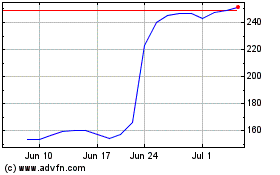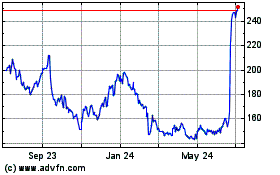Alnylam Pharmaceuticals, Inc. (Nasdaq: ALNY), the leading RNAi
therapeutics company, today presented new results from an analysis
of the UK Biobank – a prospective cohort study with genetic,
physical, and health data on approximately 500,000 individuals
across the United Kingdom – demonstrating a significant association
of the V122I mutation, a highly prevalent mutation in the
transthyretin (TTR) gene, with a clinical diagnosis of
polyneuropathy. These results were presented at the Heart Failure
Society of America (HFSA) 23rd Annual Scientific Meeting being held
September 13-16, in Philadelphia, PA.
“The data we and collaborators presented at HFSA indicate that
carriers of V122I – a TTR mutation previously thought to be
associated with a phenotype presenting primarily with cardiac
manifestations – have a significantly increased likelihood of a
clinical diagnosis of polyneuropathy,” said Eric Green, Senior Vice
President and General Manager, TTR Program at Alnylam. “These
findings demonstrate an association of V122I with the presence of a
mixed clinical phenotype, supporting the need for a broader
assessment of a patient’s overall health to look for multisystem
manifestations of hereditary ATTR amyloidosis, which often include
both cardiomyopathy and polyneuropathy.”
The V122I variant is the most common pathogenic TTR mutation
implicated in hereditary ATTR (hATTR) amyloidosis in the U.S., with
a reported prevalence of approximately four percent in African
Americans1. Historically, the V122I variant has been associated
with a predominantly cardiac phenotype. We presented findings from
a phenome-wide association study demonstrating a significant
association of the TTR V122I genotype with a clinical diagnosis of
polyneuropathy (based on International Classification of Diseases,
10th revision [ICD10] diagnosis codes) in the black subpopulation
of the UK Biobank. Among the 6,063 unrelated black participants,
243 subjects (mean age of 52.6 years) were carriers of the TTR
V122I mutation, equating to an allele frequency of two percent.
Among the carriers, polyneuropathy was significantly associated
with the V122I genotype (odds ratio [OR] equals 11.2; 95%
confidence interval [CI]; p equals 1.1x10–6). The significant
association of V122I with polyneuropathy was further replicated in
the Penn Medicine Biobank from 5,737 black participants with 190
subjects who were V122I carriers.
In addition, there was nominally significant evidence that
carriers of V122I were at an increased risk for other signs and
symptoms of hATTR amyloidosis, including carpal tunnel syndrome and
urinary retention. There was no association of V122I with
cardiomyopathy, potentially due to the younger age of the carriers
in the UK Biobank at the time of analysis (mean age of 52.6 years)
as compared to the age at which hATTR amyloidosis with
cardiomyopathy typically presents (over 65 years in the V122I
population, as reported in the literature2).
Other presentations at HFSA include:
- Identifying Mixed Phenotype: Evaluating the Presence of
Polyneuropathy in Patients with Hereditary Transthyretin-Mediated
Amyloidosis with Cardiomyopathy Lead Author: Grogan M
Date/Time: Saturday, September 14, 2019 at 6:15 pm ET.
- Risk Factors for Mortality in Patients with Hereditary
Transthyretin-Mediated Amyloidosis: Analysis of APOLLO and Global
Open Label Extension Studies Lead Author: Polydefkis M
Date/Time: Saturday, September 14, 2019 at 6:15 pm ET.
- Impact of Patisiran, an RNAi Therapeutic, on Orthostatic
Intolerance in Patients with Hereditary Transthyretin-Mediated
Amyloidosis Lead Author: Judge DP Date/Time: Friday, September
13, 2019 at 6:15 pm ET.
- Alnylam Act®: Heterogenous Disease Manifestations of
Hereditary Transthyretin-Mediated Amyloidosis Lead Author:
Malladi R Date/Time: Friday, September 13, 2019 at 6:15 pm ET.
To view these results presented at HFSA please visit
www.alnylam.com/capella.
Alnylam will host an RNAi Roundtable to discuss the latest
progress with its TTR programs on Monday, September 16, at 1:00 pm
ET. This event will be webcast live on the Investors page of the
Company’s website, www.alnylam.com, and a replay will be posted on
the Alnylam website approximately three hours after the event.
- Dhamarajan et al. J Am Geriatr Soc 2012;60:765-74.
- Ruberg and Berk, Circulation 2012;126:1286-1300.
About Transthyretin (ATTR) Amyloidosis Transthyretin
amyloidosis (ATTR) amyloidosis is a rare, serious,
life-threatening, multisystemic disease encompassing hereditary
ATTR (hATTR) amyloidosis and wild-type ATTR (wtATTR) amyloidosis,
which result from either hereditary (genetic mutation) or
nonhereditary (ageing) causes, respectively. In ATTR amyloidosis,
misfolded TTR proteins accumulate as amyloid fibrils in multiple
organs and tissue types. hATTR amyloidosis can include sensory and
motor, autonomic and cardiac symptoms and is estimated to impact
50,000 people worldwide. wtATTR amyloidosis predominantly manifests
as cardiomyopathy and heart failure symptoms, although patients may
experience other manifestations due to extra-cardiac amyloid
deposition. The disease is estimated to impact 200,000 – 300,000
people worldwide.
About RNAi RNAi (RNA interference) is a natural cellular
process of gene silencing that represents one of the most promising
and rapidly advancing frontiers in biology and drug development
today. Its discovery has been heralded as “a major scientific
breakthrough that happens once every decade or so,” and was
recognized with the award of the 2006 Nobel Prize for Physiology or
Medicine. By harnessing the natural biological process of RNAi
occurring in our cells, a new class of medicines, known as RNAi
therapeutics, is now a reality. Small interfering RNA (siRNA), the
molecules that mediate RNAi and comprise Alnylam's RNAi therapeutic
platform, function upstream of today’s medicines by potently
silencing messenger RNA (mRNA) – the genetic precursors – that
encode for disease-causing proteins, thus preventing them from
being made. This is a revolutionary approach with the potential to
transform the care of patients with genetic and other diseases.
About Alnylam Pharmaceuticals Alnylam (Nasdaq: ALNY) is
leading the translation of RNA interference (RNAi) into a new class
of innovative medicines with the potential to transform the lives
of people afflicted with rare genetic, cardio-metabolic, hepatic
infectious, and central nervous system/ocular diseases. Based on
Nobel Prize-winning science, RNAi therapeutics represent a
powerful, clinically validated approach for the treatment of
diseases with high unmet need. Alnylam’s first commercial RNAi
therapeutic is ONPATTRO® (patisiran), approved in the U.S., EU,
Canada, and Japan. Alnylam has a deep pipeline of investigational
medicines, including five product candidates in Phase 3 studies and
one in registration. Looking forward, Alnylam will continue to
execute on its "Alnylam 2020" strategy of building a multi-product,
commercial-stage biopharmaceutical company with a sustainable
pipeline of RNAi-based medicines to address the needs of patients
who have limited or inadequate treatment options. Headquartered in
Cambridge, MA, Alnylam employs over 1,200 people worldwide. For
more information about our people, science and pipeline, please
visit www.alnylam.com and engage with us on Twitter at @Alnylam or
on LinkedIn.
Alnylam Forward Looking Statements Various statements in
this release concerning Alnylam's future expectations, plans and
prospects, including, without limitation, expectations regarding
the implications of data indicating that carriers of the TTR
mutation V122I have a significantly increased likelihood of a
clinical diagnosis of polyneuropathy, including the need for a
broader assessment of a patient’s overall health to look for the
multisystem manifestations of hereditary ATTR amyloidosis, and
expectations regarding its “Alnylam 2020” guidance for the
advancement and commercialization of RNAi therapeutics, constitute
forward-looking statements for the purposes of the safe harbor
provisions under The Private Securities Litigation Reform Act of
1995. Actual results and future plans may differ materially from
those indicated by these forward-looking statements as a result of
various important risks, uncertainties and other factors,
including, without limitation, Alnylam's ability to discover and
develop novel drug candidates and delivery approaches, successfully
demonstrate the efficacy and safety of its product candidates, the
pre-clinical and clinical results for its product candidates, which
may not be replicated or continue to occur in other subjects or in
additional studies or otherwise support further development of
product candidates for a specified indication or at all, actions or
advice of regulatory agencies, which may affect the design,
initiation, timing, continuation and/or progress of clinical trials
or result in the need for additional pre-clinical and/or clinical
testing, delays, interruptions or failures in the manufacture and
supply of its product candidates, obtaining, maintaining and
protecting intellectual property, Alnylam's ability to enforce its
intellectual property rights against third parties and defend its
patent portfolio against challenges from third parties, obtaining
and maintaining regulatory approval, pricing and reimbursement for
products, progress in establishing a commercial and ex-United
States infrastructure, successfully launching, marketing and
selling its approved products globally, Alnylam’s ability to
successfully expand the indication for ONPATTRO in the future,
competition from others using technology similar to Alnylam's and
others developing or marketing products for similar uses, Alnylam's
ability to manage its growth and operating expenses, obtain
additional funding to support its business activities, and
establish and maintain strategic business alliances and new
business initiatives, Alnylam's dependence on third parties for
development, manufacture and distribution of products, the outcome
of litigation, the risk of government investigations, and
unexpected expenditures, as well as those risks more fully
discussed in the “Risk Factors” filed with Alnylam's most recent
Quarterly Report on Form 10-Q filed with the Securities and
Exchange Commission (SEC) and in other filings that Alnylam makes
with the SEC. In addition, any forward-looking statements represent
Alnylam's views only as of today and should not be relied upon as
representing its views as of any subsequent date. Alnylam
explicitly disclaims any obligation, except to the extent required
by law, to update any forward-looking statements.
View source
version on businesswire.com: https://www.businesswire.com/news/home/20190913005044/en/
Alnylam Pharmaceuticals, Inc. Christine Regan
Lindenboom (Investors and
Media) 617-682-4340
Josh
Brodsky (Investors)
617-551-8276
Alnylam Pharmaceuticals (NASDAQ:ALNY)
Historical Stock Chart
From Mar 2024 to Apr 2024

Alnylam Pharmaceuticals (NASDAQ:ALNY)
Historical Stock Chart
From Apr 2023 to Apr 2024
